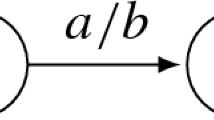Abstract
It is established that the subset of freek-generated subsemigroups of the semigroup of all automaton transformations over a finite alphabet is a second category set (in the sense of the Baire category approach) in the set of allk-generated subsemigroups. A continuum series of pairs of automaton transformations each of which generates a free semigroup of rank two is indicated. A criterion is established for this semigroup to be a finite-automaton group.
Similar content being viewed by others
References
V. A. Ufnarovskii, “Combinatorial and asymptotic methods in algebra,” in:Contemporary Problems in Mathematics. Fundamental Directions [in Russian], Vol. 57, Itogi Nauki i Tekhniki, VINITI, Moscow (1990), pp. 5–177.
V. P. Zarovnyi, “Automaton substitutions and interlacements of groups,”Dokl. Akad. Nauk SSSR [Soviet Math. Dokl.],160, No. 3, 562–565 (1965).
L. A. Kaloujnine, P. M. Beleckij, and V. Z. Fejnberg,Kranzprodukte, Teubner, Leipzig (1987).
C. Wells, “Some applications of the wreath product construction,”Amer. Math. Monthly,83, 317–338 (1976).
S. V. Aleshin, “Finite automata and the Burnside problem for periodic groups,”Mat. Zametki [Math. Notes],11, No. 3, 319–328 (1972).
S. V. Aleshin, “A free group of finite automata,”Vestnik Moskov. Univ. Ser. I Mat. Mekh. [Moscow Univ. Math. Bull.], No. 4, 12–14 (1983).
J. Tits, “Free subgroups in linear groups,”J. Algebra,20, 250–270 (1972).
D. B. A. Epstein, “Almost all subgroups of a Lie group are free,”J. Algebra,19, 261–262 (1971).
J. D. Dixon, “Most finitely generated permutation groups are free,”Bull. London Math. Soc.,22, 222–226 (1990).
M. Bhattacharjee, “The ubiquity of free subgroups in certain inverse limits of groups,”J. Algebra,172, 134–146 (1995).
V. B. Kudryavtsev, S. V. Aleshin and A. S. Podkolzin,Introduction to Automata Theory [in Russian], Nauka, Moscow (1985).
W. C. Holland, “The characterization of generalized wreath product,”J. Algebra,13, 152–172 (1969).
R. A. Aleksandryan and É. A. Mirzakhanyan,General Topology [in Russian], Vysshaya Shkola, Moscow (1979).
J.-P. Serre,Cohomologie galoisienne, Springer-Verlag, Berlin-Heidelberg-New York (1964).
V. I. Sushchans'kii, “Standard subgroups of the isometry group of the metric space ofp-adic integers,”Visnik Kiïv. Univ. Ser. Mat. Mekh., No. 30, 100–107 (1988).
Author information
Authors and Affiliations
Additional information
Translated fromMatematicheskie Zametki, Vol. 63, No. 2, pp. 248–259, February, 1998.
The author wishes to express his deep gratitude to Professor V. I. Sushchans'kii for permanent help and attention to the research.
This research was partially supported by the ISSEP under grant No. GSU 051341.
Rights and permissions
About this article
Cite this article
Oliinyk, A.S. On free semigroups of automaton transformations. Math Notes 63, 215–224 (1998). https://doi.org/10.1007/BF02308761
Received:
Issue Date:
DOI: https://doi.org/10.1007/BF02308761




